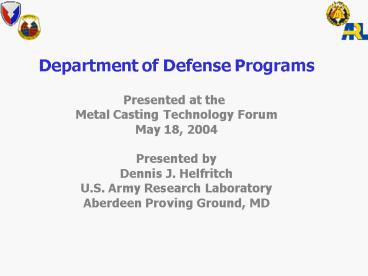Department of Defense Programs - PowerPoint PPT Presentation
1 / 16
Title:
Department of Defense Programs
Description:
... is to develop the ability to fabricate helicopter drive train housings that are ... program will develop processes to fabricate both large and small transmission ... – PowerPoint PPT presentation
Number of Views:87
Avg rating:3.0/5.0
Title: Department of Defense Programs
1
Department of Defense Programs Presented at the
Metal Casting Technology Forum May 18,
2004 Presented by Dennis J. Helfritch U.S. Army
Research Laboratory Aberdeen Proving Ground, MD
2
DoD Materials Technology Priorities
Improved Military Combat Capability Active/Adapti
ve Materials Structures Sensor Materials High
Temperature Pavements Preservation Of Aging
Assets Condition-Based Maintenance Nondestructi
ve Inspection/evaluation Corrosion
Control Fatigue Management Acquisition
Affordability Of New Equipment Advanced
Composite-fabrication Processes Advanced
Metal-fabrication Processes Environmental
Quality And Impact Metal Cleaning Processes Low
Volatile Organic and Non-Toxic Paints And
Coatings Non-toxic, Environmentally Benign
Electronic Materials Processes
Dr. Lewis Sloter, Office of the Deputy Under
Secretary of Defense (Science Technology)
3
DoD Metalcasting Priorities
- Replacement of complex structures with
single-piece castings - Lightweight castings
- Thin-walled castings
- Continuous parts supply for aging assets
- Meet existing and future emissions regulations
- Lower cost
(Ten percent of all castings are made solely for
military use.)
4
- ManTech Objective
- Develop affordable, robust manufacturing
processes and capabilities for evolutionary
metals and special materials critical to defense
weapon system applications. - Major thrust areas that support this objective
include processing methods, special materials,
joining, and inspection.
5
ManTech Planning Process
6
ManTech Funding
7
Single-Melt Process for Reduced-Cost Ti Alloys
Improved Ingot Surface Finish
The objective is to develop a single-melt Plasma
Arc Cold Hearth Melting (PAM) process where the
ingot surface finish results in a sufficient
quality that requires little or no surface
removal prior to forging. The single-melt PAM
process can potentially offer up to a 27
reduction in the acquisition cost of Ti-6-4
ingots for the LW155 Program.
Participants U.S BAE Systems, Inc. Marine
Corps RMI Titanium Company National Center for
Excellence in Metalworking Technology
Navy ManTech
8
Advanced Thin Wall CastingManufacturing Process
This Army Mantech project has successfully
demonstrated the thin wall casting process by
casting the demonstration component, the T800
engine combustor case. The wall thickness
achieved was 0.032 inches, compared to greater
than 0.100 inches for conventional casting. The
thin wall cast material was within the limits of
INCO 718 material properties database.
Participants AMRDEC Honeywell
Project completed
9
- M777 Lightweight Howitzer
The M777 program is a joint effort between the
U.S. Marine Corps and the U.S. Army to replace
aging, steel-intensive M198 155MM Howitzers. The
use of high strength titanium alloy Ti 6Al-4V for
major portions of the M777 reduces the total
weight from over 16,000 pounds to 9,000 pounds.
Participants NCEMT BAE Systems PCC
Structurals Howmet Wah Chang RTI Titanium
Engineers Nu-Tech Dynamic Machine Works
The spade of the M777 Lightweight Howitzer
Navy ManTech
10
- Cast Seal Rings for High-Speed Military Tracked
Vehicles
The extreme hardness of the alloy required to
withstand abrasive environments requires that the
seal rings be cast very close to net shape. The
alloy is difficult to cast causing high rejection
rates. High percentages of rings that pass
circularity and flatness are still rejected for
microporosity. Recommended pattern
modifications and revised venting and flange
configurations substantially reduced shrinkage
defects and dropped scrap rates from 40 to 5.
Participants AMC UAB Caterpillar AFS ATI
DLA ManTech Completed 2002
11
Affordable Helicopter Drive Train Housings
The objective is to develop the ability to
fabricate helicopter drive train housings that
are lighter in weight and can significantly
reduce operating and support costs. The program
will develop processes to fabricate both large
and small transmission housings, and new material
coating processes for magnesium housings will be
recommended.
Participants AMRDEC Sikorsky Aircraft Boeing
RAH-66 Transmission
12
Laser Additive Manufacturing
A new manufacturing process for titanium
structure fabrication, based on a stereo
lithography approach to manufacturing. Parts with
properties in the class of forgings are built one
layer at a time, making LAM a true manufacturing-
on-demand process. Cycle time is reduced by up to
80, the process is environmentally friendly and
provides tremendous surge capability.
Participants ARL AFRL DLA ONR Pratt
Whitney Aeromet Lockheed Martin Northrup
Grumman Boeing MTS
Project Complete
13
14
Points of Contact
www.dodmantech.com
15
Other Avenues
Cooperative Research and Development
Agreement (CRADA)
16
Progress
Cannon Foundry - da Vinci 1487































